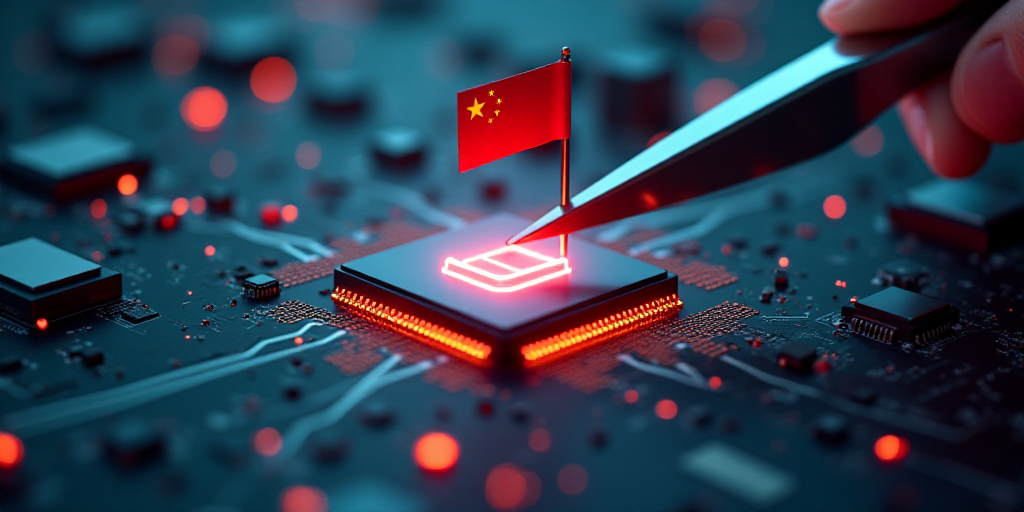Introduction
The United States has been attempting to restrict the export of advanced semiconductors to China for several years, citing national security concerns. Companies like Nvidia have opposed stricter restrictions. Here’s a detailed timeline of this technological confrontation, as Nvidia recently announced the resumption of chip sales to China for artificial intelligence (AI) applications.
August 2022: The Chips Act
Under President Joe Biden’s administration, a law was signed to bolster domestic semiconductor production. This strategic sector is of concern to Washington, which fears Chinese dominance through significant Chinese investments in their leading manufacturing facilities.
The “Chips and Science Act” allocates approximately $52 billion (€45 billion) to support the manufacturing of these crucial components that power almost all modern technologies.
October 2022: Initial Export Restrictions
The U.S. imposed sudden export restrictions on advanced chips to China, citing national security. These new rules aim to curb China’s access to semiconductors that could be used for military purposes, including chip production equipment.
China accused the U.S. of acting “maliciously,” primarily to hinder its economic development.
December 2022: Blacklisting of Chinese Companies
The U.S. added 36 Chinese companies, including several advanced chip manufacturers, to a blacklist that severely limits their access to U.S. technologies.
These companies are reportedly linked to China’s defense sector, as some are involved in the development of hypersonic and ballistic missiles.
October 2023: EU Tightens Controls
A year later, especially following the release of ChatGPT by U.S.-based OpenAI, the U.S. reinforced its restrictions.
The launch of a powerful chip by Chinese tech giant Huawei in an intelligent phone alarmed the U.S., prompting them to expand restrictions beyond Nvidia’s H100 chip to less efficient chips produced by Nvidia and its competitors.
December 2024/January 2025: Final Measures by Biden
Weeks before Donald Trump’s return to the White House, Joe Biden imposed a new set of restrictions on advanced chip exports.
One rule mandates authorization for any export or re-export, aiming to limit operations that circumvent restrictions through third countries.
The legislation provides exemptions for countries considered U.S. allies, but most face limitations.
January 2025: The Arrival of DeepSeek
DeepSeek’s AI-based conversational robot topped the download chart in Apple’s app store, impressing observers with its achievements comparable to U.S. competitors.
April 2025: Blocking of H20 Chips
Nvidia developed a new AI-specialized chip, the H20, less powerful but intended for the Chinese market. However, the U.S. informed Nvidia that it needed a license to export it to China due to potential use in supercomputers.
May 2025: Trump Reduces Restrictions
The Trump administration reviewed part of the restrictions imposed by his predecessor in response to criticisms from some countries being deprived of crucial AI technology.
There were concerns that these limitations might force those countries to rely on China, thereby fueling its technological advancement.
The U.S. Department of Commerce announced that using Huawei’s Ascend chip, the most advanced in their lineup, would violate U.S. controls. China denounced this as “harassment.”
July 2025: Resumption of H20 Sales
Nvidia announced the resumption of H20 chip sales to China following the removal of restrictions by the U.S. and just before the Nvidia CEO’s visit to China.
Key Questions and Answers
- What is the technological battle between China and the U.S. about? The dispute revolves around advanced semiconductors, with the U.S. aiming to restrict China’s access to these technologies for national security reasons.
- Who are the key players in this battle? Major U.S. companies like Nvidia, along with Chinese firms such as Huawei and DeepSeek, are central to this technological confrontation.
- What is the significance of the Chips Act? The Chips and Science Act allocates substantial funds to bolster domestic semiconductor production, aiming to prevent Chinese dominance in this strategic sector.
- How have export restrictions evolved? Initially targeting advanced chips, restrictions expanded to include less efficient chips and production equipment following concerns over AI development in China.
- What is the role of international companies in this battle? Companies like DeepSeek, despite being based outside the U.S., have contributed to intensifying the technological competition.
- How have recent changes affected the situation? The Trump administration’s partial reversal of restrictions and Nvidia’s resumption of H20 chip sales to China have created a dynamic and evolving landscape.






